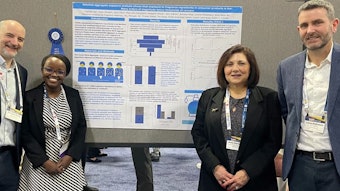The Research Institute for Fragrance Materials (RIFM) has announced a five-year respiratory safety research plan that will examine fragrance impact on airway hypersensitivity. Of the announcement, RIFM's respiratory science program manager Madhuri Singal said, “With the support of our independent advisory groups, RIFM is pleased to introduce significant new data from innovative respiratory research with an integrated approach to inhalation risk assessment. This year alone six abstracts were presented at international scientific meetings and two manuscripts will be submitted to peer-reviewed journals."
An excerpt of the official announcement appears below:
A series of studies was designed to assemble a complete picture of inhalation exposure by evaluating the following:
1. Where does the material go upon inhalation under conditions of normal consumer use?
2. If the material is deposited in the airways, what type of cellular/chemical interactions occur at the site?
3. What resulting physiological effects might be observed clinically?
To set the foundation for the research projects, a thorough review of all inhalation studies in the RIFM Database was conducted. The Database includes RIFM-sponsored studies, company-sponsored studies, and published papers from the open scientific literature. Systematic critical evaluations were performed using a protocol designed to assess the quality of the data in each study. The results provide read-across information useful for:
- Weight-of-evidence evaluation for informed inhalation risk assessment
- Publication of Fragrance Material Reviews (FMRs) by RIFM
- Quantitative Risk Assessment (QRA) for International Fragrance Association (IFRA) Standards
- Assistance in REACH registration initiatives
Respiratory research now underway at RIFM:
Dosimetry/Deposition, comprised of two studies, is the development of a predictive computational model and an in vivo exposure correlation study. These will produce a picture of inhalation exposure and potential effects. Fifteen fragrance materials and three non-fragrance controls are being tested in the model to predict deposition patterns in the airways and determine the deposited dose. Based on knowledge of the cell types in the regions of greatest deposition, the model will allow for prediction of potential physiological effects, which also will be evaluated in the in vivo inhalation exposure study. This in vivo corroboration study will establish the reliability of the model as a strong alternative to animal methods for inhalation risk assessment.
Respiratory Cellular Cytokine Profiling consists of an immune-competent, three-dimensional in vitro system containing the three main cell types present at the air-tissue interface in the deep lung. The model is particularly useful because the “inhaled” material is delivered in a life-like manner. Samples collected from these exposures will be screened for the expression of different cell mediators (cytokines) in a high throughput fashion. The trends observed in these profiles will provide valuable information for characterizing new and existing fragrance materials for potential sensitizing capability.
The Two-Box Air Dispersion Model is web-based software that calculates peak air concentrations of individual fragrance materials from one or a combination of three product categories:
- Aerosol Air Fresheners/Fine Fragrance Sprays
- Candles/Incense
- Heated Oil Plug-In Air Fresheners/Reed Diffusers
Templates, based on similarity in air dispersion patterns and intended consumer use habits, calculate the final concentration for the material of interest in each product used. The program also depicts the inhalation exposure profile for the material and calculates a cumulative inhalation exposure concentration for a 24-hour period. This model will assist product safety scientists and regulatory toxicologists in producing risk assessments.










